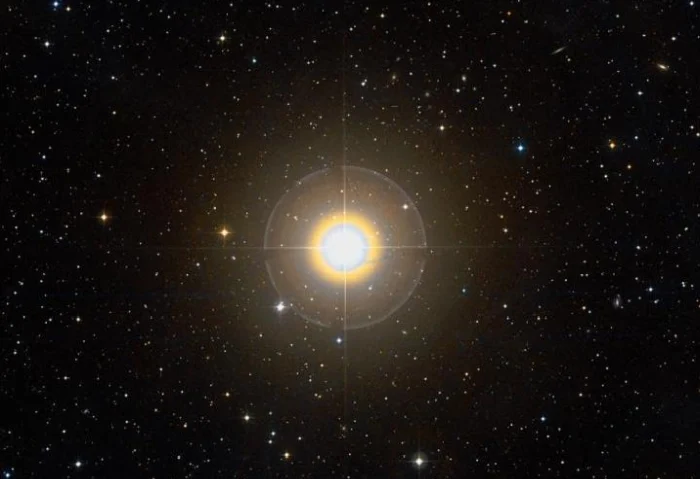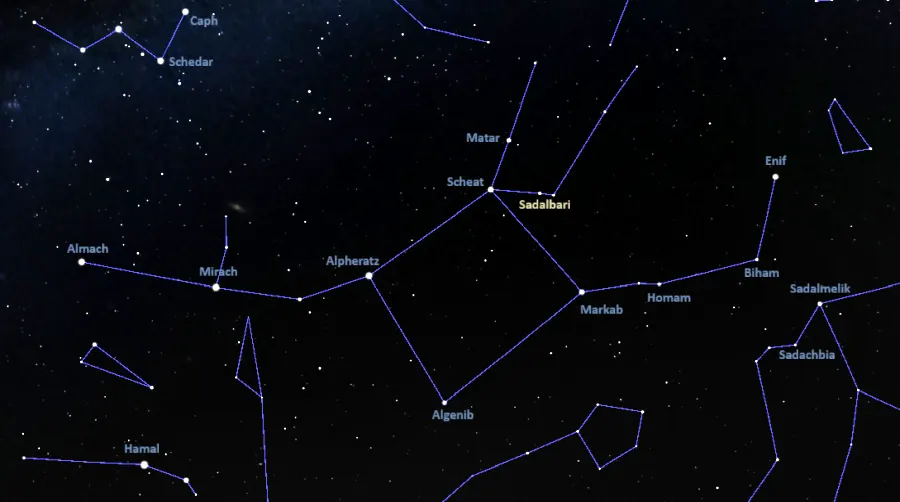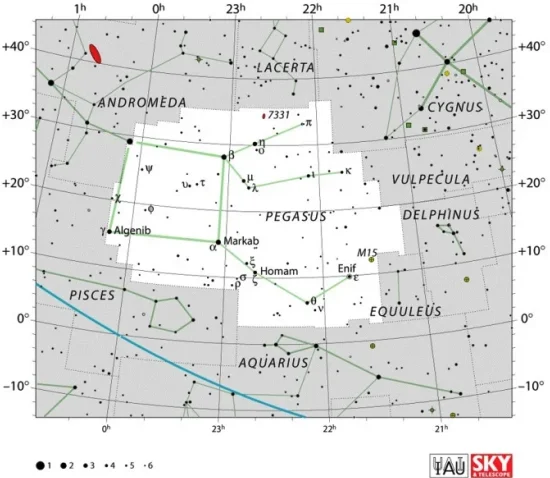Sadalbari, Mu Pegasi (μ Peg), is a yellow giant located 112.7 light-years away in the constellation Pegasus. With an apparent magnitude of 3.514, it is the seventh brightest star in the constellation. It appears in the chest of the celestial Winged Horse.
Star type
Sadalbari is a yellow giant star of the spectral type G8 III. It has 2.59 times the Sun’s mass and a radius 9.32 times that of the Sun. With a surface temperature of 4,961 K, it is 46.9 times more luminous than the Sun. The evolved star has an estimated age of 520 million years.
Mu Pegasi is a slow spinner, with a projected rotational velocity of 0.95 km/s. It is moving away from the Sun with a radial velocity of +13.791 km/s.

Sadalbari (Mu Pegasi), image credit: ESO/Digitized Sky Survey 2 (CC BY 4.0)
Name
The name Sadalbari (pronunciation: /ˌsædəlˈbɛəri/) comes from the Arabic phrase saʿd al-bāriʿ, meaning “the auspicious star of the splendid one.” The name originally applied to Mu and Lambda Pegasi. Another possible meaning is “the lucky (stars) of the excelling one.” The historical connotations are unknown. Lambda Pegasi was traditionally also called Sa’d al Nazi, “good luck of the camel striving to get to pasture.”
The International Astronomical Union’s (IAU) Working Group on Star Names (WGSN) approved the name Sadalbari for Mu Pegasi on August 21, 2016.
In traditional Chinese astronomy, Mu Pegasi was called 離宮二 (Lì Gōng èr), the Second Star of Resting Palace. It formed the Resting Palace asterism with Lambda Pegasi, Omicron Pegasi, Matar (Eta Pegasi), Salm (Tau Pegasi), and Nu Pegasi. The asterism was part of the large Encampment mansion, one of the northern mansions of the Black Tortoise. It represented an imperial palace.
Facts
Mu Pegasi forms a visual pair with the fainter Lambda Pegasi. Both are evolved stars with the spectral class G8. However, they are not physically related. Lambda Pegasi (G8 II-III) lies at a much greater distance, approximately 365 light years away. Even though it is evolving towards the luminosity class of a bright giant and has a luminosity of 397 Suns, Lambda Pegasi appears slightly fainter (mag. 3.93) than Sadalbari because it is more distant. The stars appear just southwest of Scheat (Beta Pegasi), one of the four bright stars that form the Great Square of Pegasus.
Sadalbari is one of the several stars whose names have the prefix “sad.” In Arabic, “sa’d” means “luck” or “good fortune.” Other “lucky” stars include Sadalsuud (“the luck of lucks”), Sadalmelik (“luck of the king”), Sadachbia (“luck of the homes/tents”), Sadaltager (“luck of the merchant”), and Sadalpheretz (“luck of the horseman”). Sadaltager and Sadalpheretz, the traditional names of Zeta Aquarii and Lambda Pegasi, are the only ones that have not been formally approved by the IAU.
The names Homam (Zeta Pegasi), Matar (Eta Pegasi) and Biham (Theta Pegasi) are derived from sa’d al Humam, sa’d al Maṭar and s’ad al Biham, meaning “the lucky (stars) of the hero,” “the lucky star of rain” and “the lucky stars of the young beasts,” respectively. All these stars appear in the same area of the sky, in the constellations Aquarius and Pegasus.
Location
Sadalbari can be found using the bright stars of the Great Square of Pegasus. It appears near the northwestern corner of the asterism and forms a triangle with Scheat (Beta Pegasi) and Matar (Eta Pegasi).
The Great Square of Pegasus is one of the most familiar asterisms in the night sky. It dominates the evening sky throughout the autumn months in the northern hemisphere.

Sadalbari location, image: Stellarium
Constellation
Sadalbari is located in the northern constellation of Pegasus. The Winged Horse is the seventh largest constellation in the sky, stretching across 1,121 square degrees. It was one of the 48 Greek constellations catalogued by Claudius Ptolemy of Alexandria in his Almagest in the 2nd century CE. In Greek mythology, the constellation is associated with the winged horse Pegasus, the offspring of the god Poseidon born from the blood of the Gorgon Medusa.
Pegasus is one of the most recognizable northern constellations. Its bright stars Scheat (Beta Pegasi), Markab (Alpha Pegasi) and Algenib (Gamma Pegasi) form the Great Square of Pegasus with Alpheratz (Alpha Andromedae) in the neighbouring Andromeda constellation. The bright, large asterism can be used to find many famous deep sky objects, as well as the fainter nearby constellations Pisces, Aquarius, Lacerta, and Delphinus.
Enif (Epsilon Pegasi), the brightest star in Pegasus, is a K-type supergiant that shines at magnitude 2.4 from a distance of around 690 light-years. It is one of the five stars in Pegasus that are brighter than magnitude 3.0, making the constellation easy to make out even from light-polluted areas.
Other bright stars in Pegasus include the red giant Scheat (Beta Pegasi), the evolved blue-white star Markab (Alpha Pegasi), the blue subgiant Algenib (Gamma Pegasi), the yellow bright giants Matar (Eta Pegasi) and Lambda Pegasi, the hot blue main sequence star Homam (Zeta Pegasi), and the binary star systems Biham (Theta Pegasi) and Iota Pegasi.
Pegasus also hosts IK Pegasi, one of the nearest supernova candidates to the Sun, the yellow supergiant 9 Pegasi, the orange supergiant 12 Pegasi, the fast-spinning, chemically peculiar star Salm (Tau Pegasi), and Helvetios (51 Pegasi), the first main sequence star discovered to have an orbiting extrasolar planet (51 Pegasi b, formally named Dimidium).

Pegasus constellation map by IAU and Sky&Telescope magazine (Roger Sinnott & Rick Fienberg) (CC BY 3.0)
Deep sky objects in Pegasus include the bright globular cluster Messier 15 (the Great Pegasus Cluster), the Fried Egg Galaxy (NGC 7742), the unbarred spiral galaxies NGC 7331 with the NGC 7331 Group (the Deer Lick Group) and NGC 7217, the barred spiral galaxy NGC 7479 (the Superman Galaxy), and the interacting pairs NGC 7469 and IC 5283 and NGC 7752 and NGC 7753.
Pegasus is also home to the famous Stephan’s Quintet (HCG 92), a visual grouping of five galaxies, and to the gravitationally lensed quasar known as the Einstein Cross.
The best time of the year to observe the stars and deep sky objects in Pegasus is during the month of October, when the constellation appears higher above the horizon in the early evening. The entire constellation is visible from locations north of the latitude 60° S.
The 10 brightest stars in Pegasus are Enif (Epsilon Peg, mag. 2.399), Scheat (Beta Peg, mag. 2.42), Markab (Alpha Peg, mag. 2.48), Algenib (Gamma Peg, mag. 2.84), Matar (Eta Peg, mag. 2.95), Homam (Zeta Peg, mag. 3.414), Sadalbari (Mu Peg, mag. 3.514), Biham (Theta Peg, mag. 3.52), Iota Pegasi (mag. 3.77), and Lambda Pegasi (mag. 3.93).
Sadalbari – Mu Pegasi
| Spectral class | G8 III |
| U-B colour index | +0.674 |
| B-V colour index | +0.932 |
| Apparent magnitude | 3.514 |
| Absolute magnitude | +0.432 |
| Distance | 112.7 ± 0.7 light-years (34.6 ± 0.2 parsecs) |
| Parallax | 28.9340 ± 0.1887 mas |
| Radial velocity | 13.791 ± 0.0005 km/s |
| Proper motion | RA: +145.240 ± 0.188 mas/yr |
| Dec.: −42.396 ± 0.214 mas/yr | |
| Mass | 2.59 ± 0.05 M☉ |
| Luminosity | 46.9 ± 0.6 L☉ |
| Radius | 9.32 ± 0.47 R☉ |
| Temperature | 4,961 ± 40 K |
| Metallicity | −0.03 ± 0.02 dex |
| Age | 520 ± 30 million years |
| Rotational velocity | 0.95 ± 0.45 km/s |
| Surface gravity | 2.85 ± 0.03 cgs |
| Constellation | Pegasus |
| Right ascension | 22h 50m 00.1930748087s |
| Declination | +24° 36′ 05.692620534″ |
| Names and designations | Sadalbari, Mu Pegasi, Mu Peg, μ Pegasi, μ Peg, 48 Pegasi, 48 Peg, HD 216131,HR 8684, HIP 112748, SAO 90816, FK5 862, BD+23 4615, GJ 4298, SKY# 43386, GC 31851, GCRV 14339, AG+24 2464, PLX 5528.00, PPM 114859, SRS 30862, RAFGL 2966, IRC +20537, WEB 20089, YZ 24 8764, IRAS 22475+2420, 2MASS J22500017+2436056, JP11 3540, ASCC 825572, LSPM J2250+2436, USNO-B1.0 1146-00562556, UBV 19566, UBV M 26652, GEN# +1.00216131, ROT 3323, GSC 02225-01821, N30 5024, PMC 90-93 607, TD1 29395, TIC 44155570, TYC 2225-1821-1, Gaia DR2 1876510592179102464, Gaia DR3 1876510592179455744 |